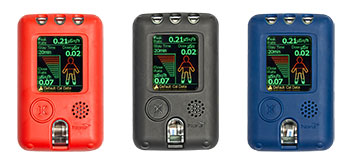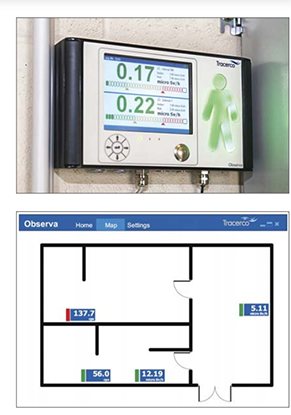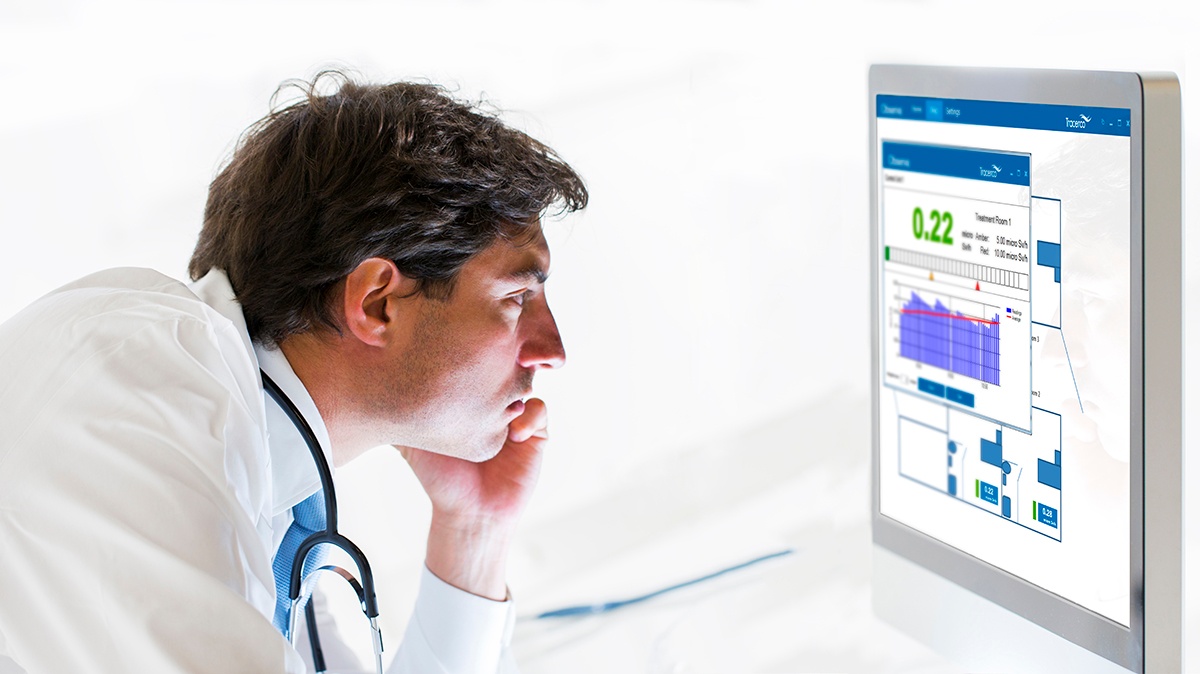When Junaid Badar, Tracerco’s Business Development Manager, attended the IAEA Emergency Preparedness and Response (EPR) Conference, he expected a valuable experience. The event exceeded expectations as the discussions closely reflected the work Tracerco does in radiation safety and radiation detection.
Tracerco at the IAEA EPR Conference: Key takeaways for radiation safety and monitoring
Posted by Kim Flynn
Dec 11, 2025 3:01:49 PM
Topics: Awards, dose rate, monitoring, radiation, monitors, ped, personal electronic dosimeter, radiation monitor, radiation detection, dosimeter
Active Personal Dosimetry in Industrial Radiography
Posted by Nick Hutchinson
Mar 13, 2018 8:29:12 AM
The International Atomic Energy Agency’s (IAEA) Specific Safety Guide No. SSG-11 which relates to Radiation Safety in Industrial Radiography states that radiography companies must ensure that employees (Category A Workers and potentially others who enter controlled areas) are subject to regular dose assessments in order to ensure that radiation doses are kept as low as reasonably achievable and dose limits are not exceeded. It is essential that reliable dose information is collected to ensure that the exposure of workers is properly controlled. Furthermore, dose assessments will also serve to highlight bad (and good) working practices. To meet this requirement, the employer will engage an Approved Dosimetry Service (ADS) so that they may provide suitable personal dosimeters together with a formal dose record keeping service.
Topics: ped, personal electronic dosimeter, radiation monitor, radiation safety, Radiation Protection, Radiation Protection Adviser, EPD, electronic personal dosimeter, radiography, personal dosimetry
How to ensure radiation safety and source security with fixed area monitoring
Posted by Tracerco
Feb 29, 2016 8:58:47 AM
Radiation safety and source security is becoming an increasing concern across all market sectors, with the illegal possession and illicit movement of radioactive sources having potentially severe consequences to site workers and both national and global communities. A necessary precaution taken by numerous facilities to ensure source security is the use of fixed area radiation monitors which provide the dose rate levels of source storage bunkers and Non-Destructive Testing (NDT) radiography bays.
Topics: radiation, radiation monitor, radiation detection, radioactive source security, observa, fixed monitoring, source theft, area monitoring, source security, radiation safety
3 steps to ensure safe working practices when dealing with radiation in a medical environment
Posted by Callum Grieves
Feb 23, 2016 11:57:09 AM
The use of radioactive sources in hospitals requires many safety measures to be implemented to ensure that workers and the general public are protected. Although there are a number of measures such as shielding, dose rate and contamination monitoring and personal dosimetry that can be used to record radiation exposure, a key method of ensuring the safety of nurses, doctors and patients, is the use of fixed area radiation monitors. Fixed area monitors use multiple detectors to provide the dose rate levels of iodine therapy centres, patient treatment rooms and nuclear medicine departments. Critical and potentially life saving information is provided as fixed area monitors incorporate 24/7 monitoring with an early warning alarm that inform patients and staff when dose rates exceed set alarm thresholds. This ensures that all radiation risks are managed safely which is key to safer working practices for all personnel working within a medical environment.
Topics: radiation, radiation monitor, medical, observa, fixed monitoring, area monitoring, radiation safety
Three reasons our Personal Electronic Dosimeter (PED) Family provides a solution for every situation
Posted by Tracerco
Jun 11, 2015 4:40:29 PM
Tracerco’s latest product range for radiation monitoring provides those working in harsh environments and potentially challenging conditions with a safe method of detecting, measuring and monitoring radiation dose rate. In this post we will discuss how our extended family of PEDs deliver exceptional performance across a wide range of applications, providing those working in CBRNe, NDT and Oil and Gas professions with an effective solution for every radiation monitoring need.
Topics: Awards, dose rate, monitoring, radiation, monitors, ped, personal electronic dosimeter, radiation monitor, radiation detection, dosimeter
Oil and Gas Comment and News
Tracerco's news and comment on measurement and diagnostics in Oil & Gas and processing industries
Tracerco brings comment, news, how tos and more on their blog. Sign up for regular notifications of new posts.
Subscribe to Email Updates
Recent Posts
Posts by Topic
- reservoir (18)
- reservoir characterisation (17)
- Gamma Scanning (16)
- chemical tracers (16)
- Flow assurance (15)
- Tru-Scan (15)
- gamma scan (15)
- people (15)
- pipeline inspection (15)
- Discovery (14)
- Process Diagnostics (14)
- employee recognition (14)
- pipeline integrity (14)
- tracers (14)
- Life at Tracerco (13)
- Subsea Technology (13)
- Working Lives (12)
- subsea flowlines (12)
- Colleague Forum (11)
- subsea pipelines (9)
- Asset Integrity (8)
- Explorer (8)
- Subsea Inspection (8)
- Subsea Integrity (8)
- Tru-Grid Scan (8)
- liquid distribution (8)
- nucleonic instrumentation (8)
- Awards (7)
- PackView Analysis (7)
- fluid inflow (7)
- optimising plant processing (7)
- packed bed towers (7)
- quantitative analysis pack beds (7)
- reservoir analysis (7)
- unconventional wells (7)
- Distillation Column Performance (6)
- Liquid maldistribution (6)
- Process Diagnostics Technology (6)
- Suspected maldistribution in packed beds (6)
- desalter optimization (6)
- excessive flare flow (6)
- flare system tracers (6)
- fracking (6)
- interwell (6)
- packed column (6)
- pipe in pipe (6)
- pipeline blockage (6)
- pipeline life extension (6)
- process diagnostics technologies (6)
- tracer technology (6)
- CT scanner (5)
- Separator (5)
- Subsea flexibles (5)
- Tracer Study (5)
- Tracerco Profiler (5)
- Tracerco innovations (5)
- distillation column maintenance (5)
- gamma scanning distillation columns (5)
- inflow measurement (5)
- packed bed performance analytics (5)
- packed bed scan (5)
- pipe bundles (5)
- pipeline extension (5)
- plant processing (5)
- radiation monitor (5)
- smart tracers (5)
- tracerco diagnostics (5)
- tray fouling (5)
- water inflow (5)
- CT scanning (4)
- NORM (4)
- NORM Management (4)
- Subsea Technologies (4)
- chemical leak test (4)
- chemical tracer technology (4)
- density of liquid (4)
- fcc diagnostics (4)
- fcc troubleshooting (4)
- fcc unit process (4)
- fccu studies (4)
- feed/effluent heat exchangers (4)
- fluid catalytic cracking unit (4)
- fugitive flare flow (4)
- gulf of mexico (4)
- hydrocarbon separation train (4)
- instrumentation (4)
- instrumentation control (4)
- multiphase separation (4)
- north sea (4)
- nucleonic instrument (4)
- oil inflow (4)
- online leak detection (4)
- process control (4)
- radiation (4)
- scanning technology (4)
- tower gamma scan (4)
- tower scanning (4)
- trayed tower (4)
- unconventional oil and gas (4)
- water production (4)
- Column Performance (3)
- Decommissioning (3)
- Downstream (3)
- Flow Study (3)
- Flowlines (3)
- FrothView (3)
- NORM Detection (3)
- Naturally Occurring Radioactive Material (3)
- Packed Beds (3)
- Radiation Protection (3)
- Radiation Protection Adviser (3)
- Tray Damage (3)
- adulterated fuel (3)
- brand authentication (3)
- brand protection (3)
- brand security (3)
- catalyst bed wash (3)
- consumer protection (3)
- controlled release (3)
- counterfeit detection (3)
- delayed coke drum (3)
- desalting (3)
- distillation column (3)
- distillation column scan (3)
- distillation column scanning (3)
- distillation tower scanning (3)
- enhanced interface control (3)
- exchanger bundle leak testing (3)
- fcc cracking (3)
- fcc services (3)
- fcc unit (3)
- fiscal tax recovery (3)
- flare flow (3)
- flare gas flow measurement (3)
- flare gas flow meter (3)
- flare study (3)
- fluid catalytic cracking diagnostics (3)
- fluid catalytic cracking services (3)
- frac wells (3)
- gamma ray inspection (3)
- gas processing (3)
- increase production rates (3)
- increased separator efficiencies (3)
- inflow (3)
- injected water (3)
- leak detection (3)
- leak tests (3)
- manage turnaround costs (3)
- mature offshore field (3)
- monitor wash bed coking (3)
- neutron backscatter (3)
- nucleonic technology (3)
- off spec product (3)
- oil & gas (3)
- oil processing (3)
- optimising oil and gas production (3)
- optimising plant production (3)
- packed column performance (3)
- packing mal-distribution (3)
- ped (3)
- personal electronic dosimeter (3)
- process condition monitoring (3)
- process systems (3)
- product quality (3)
- profiler (3)
- radiation detection (3)
- radiation safety (3)
- revenue protection (3)
- separator performance (3)
- technology enabling cost savings (3)
- tomography scan (3)
- tower scan (3)
- trayed columns (3)
- turnaround critical path project (3)
- turnaround planning (3)
- turnaround schedules (3)
- turnarounds (3)
- verify flow meters (3)
- water breakthrough (3)
- waterflood (3)
- waterflood injection (3)
- well development (3)
- wellbore (3)
- Catalytic cracking (2)
- Damage to vessel internals (2)
- Depropanizer scan tray damage (2)
- Engineering (2)
- Events (2)
- Flooded Memeber Inspection (2)
- Flow distribution (2)
- High temperature plant processing (2)
- Houston events (2)
- INWED22 (2)
- Imagine the Future (2)
- International Women in Engineering Day (2)
- Inventors and Innovators (2)
- Level+ (2)
- Maths (2)
- PhaseFinder (2)
- Radiation Waste Adviser (2)
- SAGD (2)
- SRU Unit (2)
- STEM (2)
- Science (2)
- Subsea (2)
- Sulphur Recovery Unit (2)
- TENORM (2)
- Technology (2)
- ThruVision scan (2)
- Tracerco technologies (2)
- Tray Capacity (2)
- Upstream (2)
- Women in STEM (2)
- Women in engineering (2)
- annular liquid distribution (2)
- area monitoring (2)
- authentication (2)
- baseline scan (2)
- brand protection technology (2)
- coke (2)
- coke buildup (2)
- coke deposits (2)
- coke drum (2)
- coke drum cycle (2)
- coke drum optimization (2)
- coker optimization (2)
- column troubleshooting (2)
- counterfeiting (2)
- cracking unit (2)
- desalter (2)
- dose rate (2)
- dosimeter (2)
- drilling (2)
- employees (2)
- exchanger (2)
- fcc (2)
- fcc process (2)
- fcc riser (2)
- fcc units (2)
- fccu process (2)
- fccu unit refinery (2)
- fixed monitoring (2)
- flare flow measurement (2)
- flare flow meter (2)
- flare flowrate data (2)
- flare gas meter (2)
- flare gas meters (2)
- flare lines (2)
- flare measurement (2)
- flooded trays (2)
- flow profiling (2)
- flow rate calculations (2)
- flowrate (2)
- fouling (2)
- fouling deposits (2)
- fuel fraud (2)
- gas flow meter proving (2)
- gas meter proving techniques (2)
- inflow tracer (2)
- insights (2)
- leaking exchangers (2)
- level detection devices (2)
- liquid restriction (2)
- marketing (2)
- mechanical integrity (2)
- monitoring (2)
- monitors (2)
- observa (2)
- oil in water (2)
- oil production (2)
- pigging (2)
- pre-turnaround scans (2)
- process diagnostics systems (2)
- process equipment (2)
- process vessels (2)
- product authentication (2)
- product protection (2)
- reservoir production modeling (2)
- residual oil saturation (2)
- safeguard brand equity (2)
- safeguard brand quality (2)
- safety (2)
- safety awareness (2)
- safety stand-down (2)
- separator study (2)
- shale (2)
- shale production (2)
- small leaks (2)
- solids buildup (2)
- stuck pig (2)
- tracer analysis (2)
- water tracer (2)
- well communication (2)
- work safe home safe (2)
- workplace safety (2)
- Ammonia converter (1)
- Be Safe (1)
- Blockages in perforated plates (1)
- CCS (1)
- CCUS (1)
- CDU (1)
- Carbon capture and storage (1)
- Carryover (1)
- Column Flooding (1)
- Demulsifier Chemical (1)
- Digital Marketing (1)
- EHS (1)
- EHS behaviour (1)
- EHS culture (1)
- EPD (1)
- Entrainment (1)
- FCCU (1)
- FMD (1)
- FMI (1)
- Global exchange (1)
- H2S Absorber (1)
- Heavy oil (1)
- InDepth (1)
- Intercat (1)
- Life cycle management (1)
- NORM Monitor-IS (1)
- NORM Survey Meters (1)
- OTC (1)
- PSV (1)
- Physics (1)
- Platform Members (1)
- Platform Memeber Integrity (1)
- Platform Structural Members (1)
- SEO (1)
- Suspected maldistribution (1)
- ThruVision (1)
- Tracerco Day (1)
- Tray weeping (1)
- Water Ingress (1)
- Weeping (1)
- activities (1)
- adulteration (1)
- authentication solutions (1)
- authentication, product authentication (1)
- beer column (1)
- brand (1)
- brand protection tehnology (1)
- butadiene condenser (1)
- butadiene purification unit (1)
- calibrate flow meters (1)
- catalyst loss (1)
- celebration (1)
- coker units (1)
- counterfeit fuel (1)
- critical path (1)
- critical path planning (1)
- crude distillation unit (1)
- crude unit (1)
- crude vacuum tower (1)
- debutanizer (1)
- desalter maldistribution (1)
- desalter performance (1)
- distillation column service (1)
- distillation tower scan (1)
- distribution study (1)
- education (1)
- electronic personal dosimeter (1)
- environmental reporting (1)
- exchangers (1)
- extraction tower (1)
- fcc addition systems (1)
- fcc additives (1)
- fcc reactor (1)
- flare gas measurement (1)
- foam profile (1)
- fouled trays (1)
- fouling accumulation (1)
- fracture diagnostics (1)
- fuel adulteration (1)
- fuel marker (1)
- fuel marker technology (1)
- fuel marking (1)
- fuel smuggling (1)
- fugitive emissions (1)
- gamma ray inspection distillation (1)
- gamma scan distillationcolumns (1)
- gammatrac (1)
- gas flow meter prover (1)
- gas plant (1)
- gas undercutting (1)
- grout monitoring (1)
- health and safety (1)
- heat exchanger (1)
- heat exchangers (1)
- interface levels (1)
- leak study (1)
- leak testing (1)
- leaking pressure safety valve (1)
- leaking psv (1)
- liquid carry-over (1)
- liquid liquid extractor (1)
- marker systems (1)
- mass transfer diagnostics (1)
- medical (1)
- mental wellbeing (1)
- mobile tracer labs (1)
- new technology (1)
- oil residence time test (1)
- outdoor fun (1)
- personal dosimetry (1)
- pig run (1)
- pig tracking (1)
- pig tracking services (1)
- plant performance (1)
- polymer tracer technology (1)
- polymerisation (1)
- popcorn polymer (1)
- pre-turnaround planning (1)
- pressure safety valve (1)
- process optimisation (1)
- process pipes (1)
- product assurance (1)
- providing insight onsite (1)
- radioactive source security (1)
- radiography (1)
- reactor cyclone (1)
- reactor distributor (1)
- reactor riser (1)
- reactor stripper (1)
- real-time insights (1)
- real-time measurement (1)
- refining (1)
- refractory depth (1)
- refractory lined pipes (1)
- refractory lined vessels (1)
- refractory loss (1)
- refractory measurements (1)
- regenerator cyclone (1)
- remaining oil saturation (1)
- reservoir fluid inflow (1)
- reservoir stimulation (1)
- responsive design (1)
- riser reactor (1)
- risers (1)
- safety behaviour (1)
- safety culture (1)
- safety education (1)
- separation tower scanning (1)
- separator systems (1)
- shutdown planning (1)
- shutdowns (1)
- source security (1)
- source theft (1)
- tower performance (1)
- trayed extraction tower (1)
- wash bed optimization (1)




